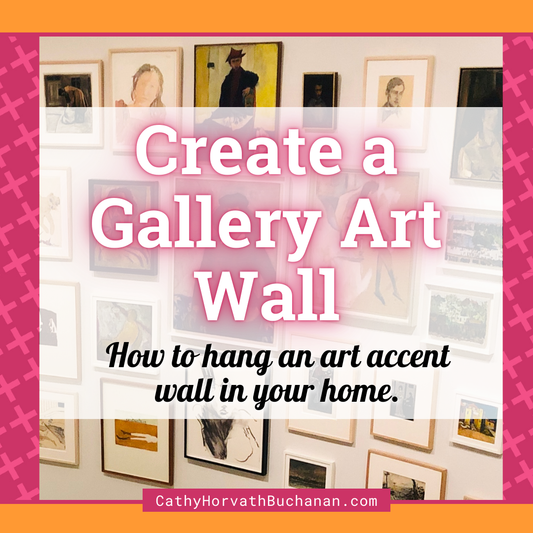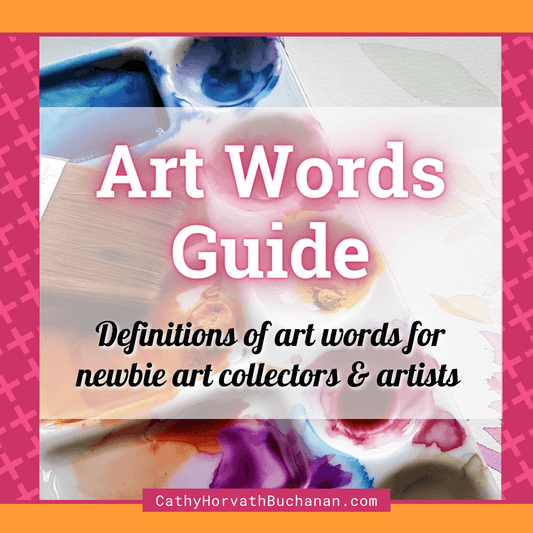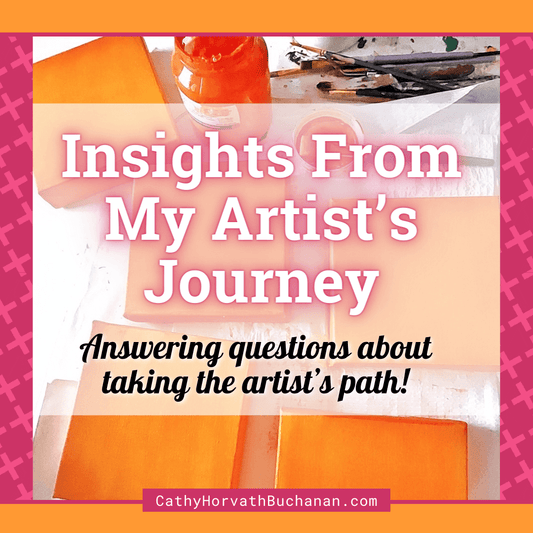Lessons from my daily 'Plein Air Painting Challenge'
What I learned creating 30 plein air paintings in 30 days!
During the 30 days of September I was feeling equal parts artist, botanist and bumble bee. I'm going to share with you a behind the scenes view of the ups and downs of creating 30 plein air paintings in 30 days from my perspective as an artist.
If you've heard the term 'plein air painting' before, but weren't sure what it was, or if you're an art collector curious about what goes into creating a group of paintings, or maybe you're an artist interested in finding out how another artist approaches a painting challenge, then this post will answer all that for you.
You'll get the inside scoop on supplies, pros and cons, and reflections on the challenge of creating a plein air painting every day, so that you can understand the value of the artwork from an artist's perspective, and find out just how difficult it is to create a unique body of artwork.
I committed myself to being outdoors each day for the month of September to create a daily plein-air painting to highlight some of the fall flowers and botanicals I encountered. I labeled this collection of paintings my ‘Autumn Art Journal’.
What is plein-air painting?
Plein-air is the act of creating a painting directly from the subject in real life (not from a photo). Often it’s a landscape that’s the subject, but I connected more with the wide variety of colorful autumn flowers I was seeing around, both wildflowers and those in the garden.
The subject is a key factor in creating any painting. With plein air painting the whole point is having the subject right in front of you live and in real life, so finding something interesting to paint everyday is crucial in this type of painting challenge, and in itself is quite challenging.
The first few days of a multi-day practice are the hardest since you're still figuring out your process and finding a reliable source of inspiration to keep you going throughout all the days of the project... mine turned out to be flowers.

Flowers are the perfect painting subject!
Flowers are basically pure form and color, making them a wonderful choice of subject to experiment with. I encourage anyone just beginning to learn how to paint to consider starting with flowers as they provide the perfect vehicle for practicing color mixing, shading and composition.
It's only by looking closely at many kinds of flowers that you see just how interesting, and uniquely beautiful every bloom is. We label them all 'flowers', but each one is so varied, with differences evolved over time to help the plant survive by enticing pollinators with their rich colors, heavenly fragrance and inviting shapes.
My goal with each painting was to capture the essence and particular qualities of the blossom, while still creating a dynamic composition with contrasting colors and expressive brushwork in order to achieve a successful artwork.
Plein air helps you 'see' things differently…
Painting is essentially organized seeing. You untangle the information you’re seeing and decide whether to include it and how to include it, usually it’s a case of simplifying and editing what you're seeing so you only convey the important relevant and beautiful bits.
From an artist’s perspective working directly from the subject is a different way of ‘seeing’ than working from a photo or from imagination. With plein-air time is limited as things are always changing or moving, you must stay aware of that and work the painting all over to avoid getting hung-up on details in just one section.
On the plus side, when painting from life you get an overall more complete picture of the subject both visually and environmentally. All your senses come into play being on the location, versus working from a static photo which is flat with none of the extra sensory inspiration.
Here’s what I learned from 30 days of painting plein air…
The majority of artworks I’ve created in my artistic career have been colorful landscapes created from my imagination, (but informed by reality). I think that experience differentiates the plein-air that I create compared to many other artists as I tend to 'make up' bits if I don't like what I'm seeing.
My intention is never to reproduce the subject or create a painting that is reportage. I take liberties and impose my artistic vision in order to highlight the interesting parts of the flowers that make them unique from the others. When I’m painting, if I think adding, taking away, or changing something will add interest or clarity, I'll do it for the sake of the painting.
I learned a great deal during this project even though I’ve been a professional artist for many years! I actually learn something from each painting I create. Experimenting with a new way of creating always shakes things up and supercharges the learning curve. During this daily project the things I learned from one painting made it into the next painting, and so on, for each successive painting.
For me, the 30 days ended up being not just an artistic journey of creation, but also of discovery. I learned that not every painting will be good, but some will be fantastic!
My supplies and approach to the daily plein air painting challenge…
I started by building a portable easel from a small tripod and adding some pieces of masonite panel that I cut to make the painting platform and palette shelf. I also recycled a tote bag with many pockets to hold my supplies (see photo below).
Supplies in my plein air painting kit: paint, paintbrushes, tray palette, pre-cut paper to paint on, easel (tripod with attachments), bottle of water, paint water cup, pencils, eraser, pencil sharpener, rags, sunscreen, big sun hat, spring clips/clamps, a collapsible stool to sit on, towel, phone, earbuds (to block out sound and listen to music/podcasts), second small tripod for photos/videos of work in progress. I think if doing this on a regular basis a white sun umbrella would also be very useful.
I created a free download checklist for things to remember to take when plein air painting, along with some useful tips, fill out the form below to get it sent to your inbox!!!
Having settled on the idea of painting fall flowers, each day I would peruse the wild areas and gardens around my home to see if there were any interesting flowers, berries or foliage in bloom that I could use to create an interesting composition.
I either painted the flowers on location, or gathered them to bring home to create a display to work from directly. I found it easier to paint at home since I could control things such as the direction of sunlight, but it was also more comfortable with a handy bathroom and coffee/snacks lol. Even though fall weather can be iffy where I live in Canada, I was lucky to have wonderfully warm days with very little rain throughout the 30 days.
Side note about bees... it wasn’t till I embarked on this endeavor that I realized just how busy bees are! When you stare intently at a flower for a couple hours you see just how much insect action happens in each blossom, sometimes more than one bee at a time would be collecting pollen from the same flower, it was delightful to see!

The pros and cons of this daily plein-air method of working…
As with anything there are pros and cons. Here are a few that I found from my experience with this daily plein air painting project. Not every artist will agree with this list, these are just my personal takeaways...
Pros, what I liked and learned...
1. Painting every day is a practice that hones your skills of painting & composition. From color mixing to mark making, it’s only through repetition that you begin to understand how it all works together.
2. Daily painting creates a work ethic, where you don’t wait to be inspired, you go in search of inspiration and just get to work.
3. When you sharpen your skills it builds confidence to help you push through when the going gets tough, so that you abandon fewer paintings. I’ve often found the paintings where I struggled most end up being the strongest and most successful. Many inexperienced painters will give up when they think the painting isn’t going well, the key is to analyze and problem-solve what you like and don’t like about what you have so far, and try to add more of the part that is working.
4. A daily painting practice is a shortcut to finding your own special style. What you learn from each painting is how you come to a style as you’ll keep repeating those things that are working well for you. The ‘working well’ part will be different for every artist and that’s where your style comes from.
5. You get a better sense of all aspects and angles of the subject by painting directly from the subject, that you can’t get if just working from a photo.
6. You learn to work the painting all over by quickly in order to establish the broad strokes of the painting, then as time and subject allows, keep working to focus the vision.
Cons, the struggle in creating paintings this way...
1. Weather is a problem when painting outdoors, be it rain, wind, or too hot/cold or you don't have enough daylight (ie the sun sets lol)
2. It takes a lot of time to post a painting every day for sale on your website and social media, leaving not much time for anything else in your life
3. Finding a viable subject can be difficult. With plein-air when you see a flower in bloom one day, it may not be there the next, so it’s a little hard to plan ahead.
4. You only have a short time to capture the subject when you're painting on site, as that subject may change quickly (I once got half way through a painting only to have a truck park in front of my view lol)
5. The direction of the sun is a problem since you don’t want to face it unless you have a very large hat or umbrella to shade your eyes, and you don’t want sunlight to land on your paper.
6. Small paintings take just as much artistic effort as larger ones. It's the work that goes into finding the subject and figuring out how you're going to convey that subject that takes most of the effort, making that a bit larger or smaller doesn't really add to much to the work of it
My conclusions after 30 days of daily plein air painting…
There are many reasons why an artist would choose to embark on a painting a day challenge. I took part in two painting challenges in 2023. The first one ran the month of January where I created a daily flower painting based on photos from my camera roll, (since here in Canada there are no flowers in January.)
The second one in September was the plein-air challenge that I talk about in this article. It was based on the ‘Strada Easel Challenge’ and I stuck to their rules, so it was definitely harder than the first challenge.
Creating during certain hours of the day based on the available sunlight and directly from a changeable source added a fair bit of stress to the creation process. After each painting was completed I then added it to my online art studio shop.
I would take part in another painting a day challenge, but I think I would mix it up a bit to keep it interesting for me and my audience by using different materials, the time-frame, and as well as the way I make the paintings available to my collectors for purchase.
The listings in my online studio shop show more photos that include the finished pieces, the works in progress along with inspiration for the piece, and a description of the subject with my thoughts about the painting.
















